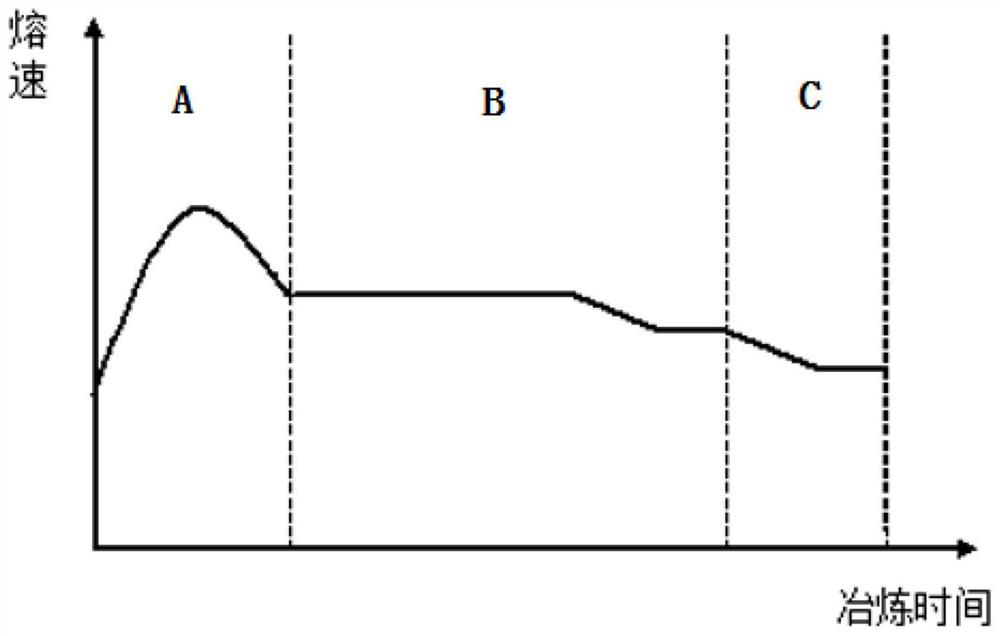Smelting method for controlling aluminum and titanium burning losses of iron and nickel-based high-temperature alloy electroslag ingot
A high-temperature alloy and smelting method technology, applied in the field of high-temperature alloys, can solve problems such as fluctuations in the mechanical properties of steel ingots, affecting the consistency and stability of alloy performance, affecting the pass rate, etc., and achieve the effect of solving the problem of burning loss
- Summary
- Abstract
- Description
- Claims
- Application Information
AI Technical Summary
Problems solved by technology
Method used
Image
Examples
Embodiment 1
[0040] Example 1. A method for smelting high-titanium-low-aluminum iron-nickel-based superalloy electroslag ingots to control burning loss of aluminum and titanium
[0041] This example mainly introduces a high-titanium-low-aluminum iron-nickel-based superalloy electroslag ingot smelting method to control the burning loss of aluminum and titanium. The specific smelting method and parameters include:
[0042] (1) The composition and weight percent of the high-titanium and low-aluminum iron-nickel-based superalloy are: Fe matrix, Ni 41.5, Cr16.0, Al 0.3, Ti 1.8, Nb 3.0, C 0.02; The composition and weight percentage of nickel-based superalloys are casted into vacuum induction ingots by using a vacuum induction melting furnace to smelt and refine metal raw materials or returned materials (for specific technical parameters, refer to patent 201910803960.4). Electroslag remelted electrode SA1 (ie, smelting electrode) was prepared after cleaning.
[0043] (2) Electroslag ingot diamet...
Embodiment 2
[0054] Example 2. A method for smelting iron-nickel-based superalloy electroslag ingots to control burning loss of aluminum and titanium
[0055] This example mainly introduces a high-titanium-low-aluminum iron-nickel-based superalloy electroslag ingot smelting method to control the burning loss of aluminum and titanium. The specific smelting method and parameters include:
[0056] (1) The composition and weight percent of the high-titanium-low-aluminum iron-nickel-based superalloy are: Fe matrix, Ni 53.0, Cr18.0, Al 0.5, Ti 0.9, Nb 5.0, Mo 3.0, C0.02; The composition and weight percentage of nickel-based superalloys with titanium and low aluminum are cast into vacuum induction ingots after smelting and refining the metal raw materials or returned materials in a vacuum induction melting furnace (for specific technical parameters, refer to patent 201910803960.4), and then through Electroslag remelting electrode SA2 (ie, smelting electrode) was prepared after the surface of the ...
Embodiment 3
[0068] Example 3. A method for smelting iron-nickel-based superalloy electroslag ingots to control burning loss of aluminum and titanium
[0069] This example mainly introduces a high-titanium-low-aluminum iron-nickel-based superalloy electroslag ingot smelting method to control the burning loss of aluminum and titanium. The specific smelting method and parameters include:
[0070] (1) The composition and weight percent of the high-titanium-low-aluminum iron-nickel-based superalloy are: Fe matrix, Ni 53.0, Cr18.0, Al 0.5, Ti 0.9, Nb 5.0, Mo 3.0, C 0.01; The composition and weight percentage of low-aluminum nickel-based superalloys are casted into vacuum induction ingots by using a vacuum induction melting furnace to smelt and refine metal raw materials or returned materials (for specific technical parameters, refer to patent 201910803960.4). Electroslag remelting electrode SA3 (ie, smelting electrode) is prepared after the surface of the induction ingot is machined clean.
[...
PUM
| Property | Measurement | Unit |
|---|---|---|
| diameter | aaaaa | aaaaa |
| weight | aaaaa | aaaaa |
| diameter | aaaaa | aaaaa |
Abstract
Description
Claims
Application Information
 Login to View More
Login to View More - R&D
- Intellectual Property
- Life Sciences
- Materials
- Tech Scout
- Unparalleled Data Quality
- Higher Quality Content
- 60% Fewer Hallucinations
Browse by: Latest US Patents, China's latest patents, Technical Efficacy Thesaurus, Application Domain, Technology Topic, Popular Technical Reports.
© 2025 PatSnap. All rights reserved.Legal|Privacy policy|Modern Slavery Act Transparency Statement|Sitemap|About US| Contact US: help@patsnap.com

